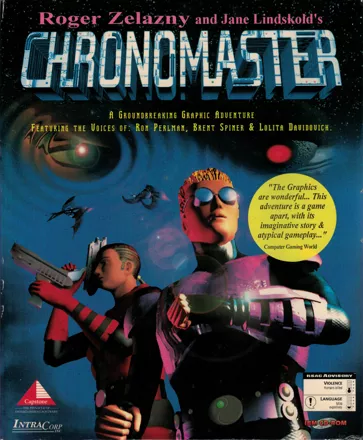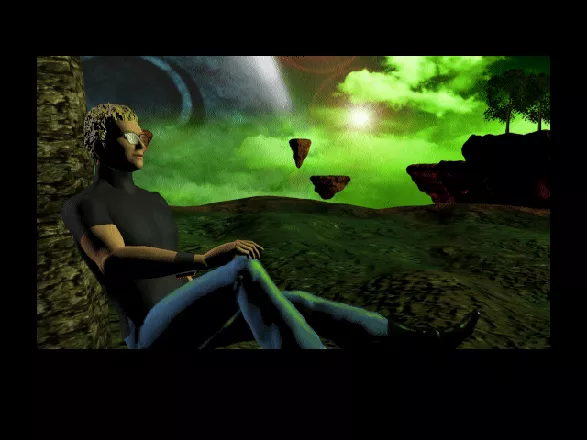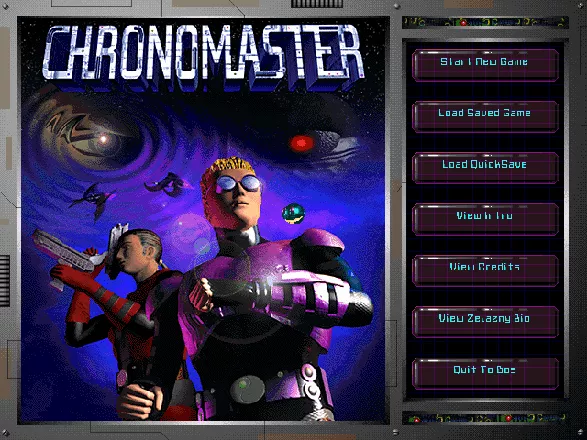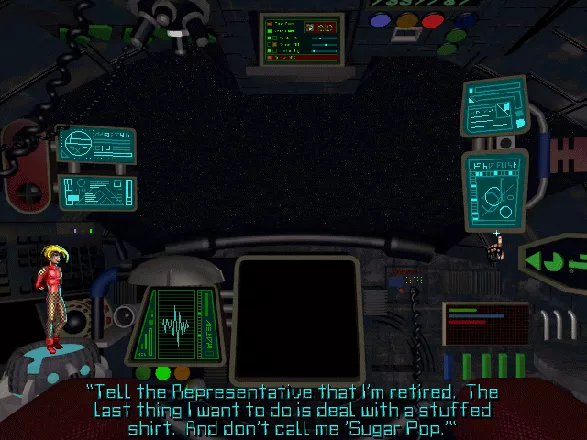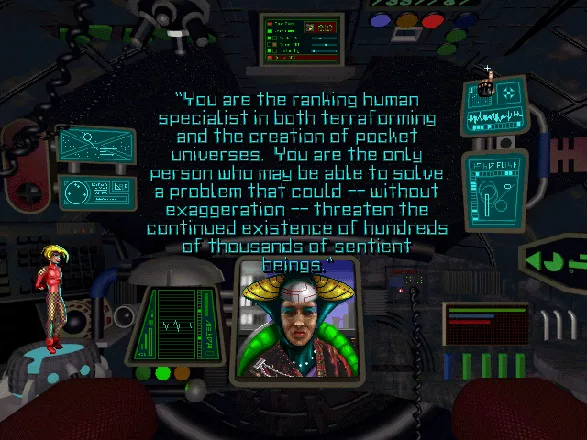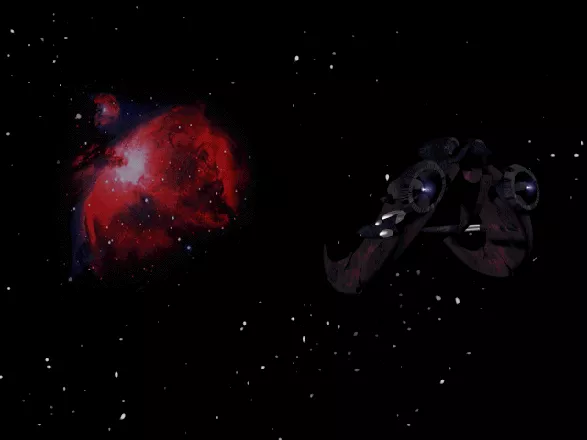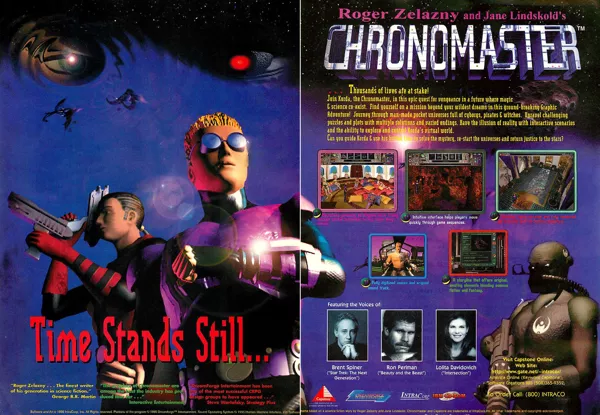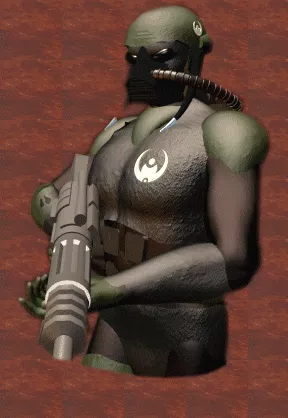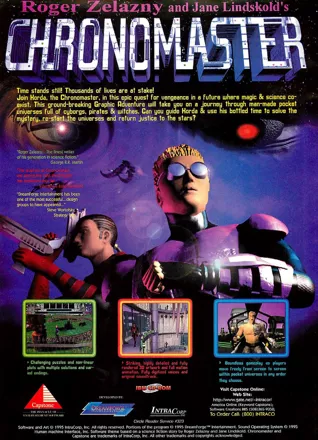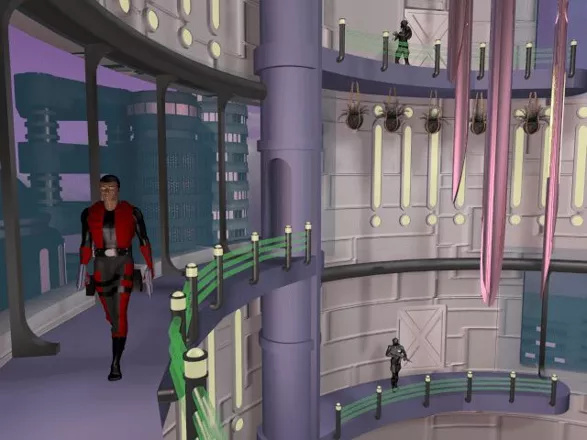Chronomaster
Description official descriptions
Chronomaster is an adventure game, written by two famous science fiction authors, Roger Zelazny and Jane Lindskold.
It takes place in a future where universe creation has been taken to an art form with the advent of Pocket Universes (a concept introduced in this game by Zelazny). In the game you play the role of Rene Korda, one of the most respected creators of Pocket Universes in the galaxy. The Terrn Regional Government asks you to intervene when five Pocket Universes are put to stasis by an unknown force.
Screenshots
Promos
Credits (DOS version)
60 People · View all
| Lead Design | |
| Engine Design | |
| Programming | |
| Graphics / Artwork | |
| 3D Modelling | |
| Music | |
| [ full credits ] | |
Reviews
Critics
Average score: 73% (based on 18 ratings)
Players
Average score: 3.8 out of 5 (based on 23 ratings with 4 reviews)
A bundle of excellent ideas hidden under an avalanche of flaws.
The Good
1996 would appear to have been a good year for adventures by notable sci-fi authors. This too is one of those rare species, and unusually, it openly admits to being a collaboration between a fairly large crowd of people.
The title on the box says "ROGER ZELAZNY and Jane Lindskold's CHRONOMASTER." From the preface in the manual, it sounds like Lindskold expanded an originally non-interactive story by Zelazny while working closely with him, and, here's the interesting bit:
"Scot Noel of Dreamforge was in touch at least once a week, running ideas by us, telling us what would work - and what wouldn't. Sometimes he sprung truly delightful surprises on us."
The preface also says that neither Lindskold nor Zelazny knew much about computers. I wonder, though, how many adventures Lindskold had played before writing this game; if she had played only a few, or none, then Chronomaster works astoundingly well for it. In fact, considering the unusual layout of this design team, the flaws of the game seem to be in all the wrong places than what you would expect.
But let's take a look at the story first:
It's the year lots and lots, and people have become so filthy rich they can have their own sealed-off solar systems, complete with disparate laws of physics. Our hero, Rene Korda, is a retired designer of such pocket universes. He's lured back to work by an intriguing problem; someone is shutting down pocket universes, stopping time within them.
To be able to move within these frozen universes, you carry "bottled time", which is a briefcase of green globules. Strap one to your back, and you can move around unfrozen; use a globule on something, and it will move as well. While this may sound somewhat cheesy, it works wonderfully in play. To start time up again within each universe, you have to locate the "world key" by setting sail for magnetic north, placing a tripod-gadget on the exact spot, then running around with a tracer gadget to hunt down the key.
You may think that navigating through a frozen world should be like stealing candy from a baby; however, Korda needs to have a time bubble around him, which means anything he touches suddenly springs to life again. And of course he never, ever, has a clear path to magnetic north.
You visit several pocket universes, and as mentioned, each can and often do have their own variation on physics. The themes of the planets are all over the shop, and the fact that these are artificial worlds actually justifies all sorts of random characters and constructed problems. Not to mention that the frozen-time element is the best excuse ever for having the world revolve around the player character.
Sounds fun, right?
The Bad
Now, in the early 90's, graphic adventure interfaces were torn between the robust interaction provided by the LucasArts-style collection of verbs at the bottom of the screen, versus the more graphical Sierra-style of pop-up icons. So the designers of Chronomaster decided to blend the two, yielding the absolutely worst-of-both-worlds solution:
Initially, the command bar is a single line on the top of the screen, which, in the middle, displays the name of the object your cursor is hovering over and, on the left, three action icons, which were apparently chosen by throwing darts at a dictionary - I mean, look/talk/push? To see all the commands, you have to click the line of text in the middle. This pulls down a veritable forest of icons, arranged in no particular order. And yes, to choose the 'walk' icon, you must pull down the full command bar, and no, there are no keyboard shortcuts. It's the future, see. People don't use keyboards in the future.
The worst product of this philosophy of forcing you to wait for the interface to finish arsing around is the U-Tool. The Universal Tool is Korda's futuristic Swiss army knife, containing a screwdriver, a hammer, and a magic wand. To use any of these, you click the U-Tool icon on the command bar, which pops up a window in the middle of the screen listing the three functions. You then have choose the function you want. This, of course, gets very tedious very fast, which means you wind up forgetting about it, which spells disaster when you do need one of its functions. The command bar is already overflowing with icons, so how could it have hurt to add three more buttons?
This kind of thing permeates the entire game, trying to impress the player with irrelevant eye candy. For instance, accessing your spaceship's database or navigation system forces you to wait fifteen seconds just so you can thrill at the animation of Korda's chair spinning around. It's three-dee, baby, you just have to be impressed.
The final nail in the interface coffin is that Korda is an object; to make him wear or drink an item, you use it on his body. In combination with the way the 'walk' icon is obscured, this becomes annoying when you want to try a bunch of items on something in the environment and Korda stands in the way. So you try one item, hunt up to the command bar for the 'walk' icon, move Korda out of the way, then you try another item, then move him away again... Before long, you'll want to throw heavy things at your monitor.
And then there are the graphics. Unfortunately, the developers jumped on the 3D pre-rendering bandwagon while the technology was still in diapers, and so, like several mid-90's games, it ends up not only looking horribly dated by today's standards, it also looks bad next to a lot of early-90's games. Even if you manage to set your brain into cheap-3D-appreciation-mode, close-up animations of Korda are simply too pathetic for words: his sluggish motion and plastic-sheen skin makes him look like an action figure with a serious motoric disorder.
When reporting on your actions, speech is sometimes used and sometimes not. Speech quality varies wildly, and sometimes, a high-pitched whine is mixed up with the spoken line.
But, once I adjusted to all these flaws I did become hooked on the game - there was just enough good stuff to get by on, even through the second most annoying maze I've ever been subjected to. And the universe where nothing has to make sense, because it's magic. And- well, remember those 'world keys'? One of them is a sliding-block puzzle.
There are pointless deaths. There are dead ends. There are several remember-the-sequence puzzles. There are conversation puzzles where you have to blindly guess the right line or die. There are many, many red herrings choking up your inventory, which further cramps the interface.
Despite these unforgivable showstoppers, I kept playing, because the story is original, the settings are varied and there are even some good puzzles, though they're very much a mixed pleasure when experienced through the horrid interface.
At a guess, I'd say this is a rare example of a game failing not, as it usually goes, because of a writer who doesn't understand interactivity, but because the techies came up short. It really doesn't look like there were any inspired people on the technical side with a thorough understanding of interface and the more craft-like aspects of adventure design. Or a grumpy bastard threatening to lynch the first person to propose a maze. Or a crack team of playtesters.
And that's a crying shame, because underneath this pile of dross you can clearly see the contours of greatness.
The Bottom Line
This may be an important game in the field of sci-fi adventure, but unless you're a complete masochist, you'll want to pack a walkthrough, and something for a headache.
DOS · by Ola Sverre Bauge (237) · 2004
I felt like Alice in science fiction Wonderland
The Good
Chronomaster is a point-and-click adventure game which tries to mix science fiction with fairy tales. The result has all the weirdness of an “Outer Limits” episode.
Six unique planetary systems make up the “pocket” universes, all frozen in time “stasis” by an unknown perpetrator. Some of the planets are truly bizarre while others are more realistic. There are a myriad of characters including unicorns, plants that talk, pigs that fly, witches, sprites, belly dancers, soldiers, gamblers and more.
The game appears to be aimed at the science fiction audience, and it starts out that way (on a space ship with all sorts of gadgets and gizmos at your disposal), but it turns out to be more whimsical fantasy than the purist sci-fi fan might like. Although set in the future, the planetary worlds you visit were created with altered physics, making magic possible. This lends itself to creative imagination, often to the extreme.
Your quest is to restore each world to normality, such that it is, by locating its “world key” and positioning it on the planet’s “magnetic north” with the aid of a “resonance tracer”. Nothing can be transferred between the worlds and your adventure is confined to that location once you land upon it. You are able to move about freely, even though everything else is still, because of the “bottled time” you carry with you and surrounds you as you explore. Walking too closely to a frozen person or object can release it, sometimes causing unexpected results, so you need to be on your toes all the time.
With a little practice, I was comfortable with the interface after only a few minutes. Action icons for look, talk, open, take, use etc. appear on the menu bar at the top of the screen, but also can be accessed by a right mouse click. A right click also lets you scroll through your object inventory, which can become quite large as you progress.
The locations are richly detailed and visually interesting and there are various types of puzzles to solve, some on the hard side. You’ll find numerous conversation-based puzzles (i.e., help him and he’ll help you), one of the most annoying mazes I’ve ever seen, plus other traditional puzzle types. Some of the puzzles can be considered really imaginative, while others are just obstacles in your path.
The game has several possible endings depending upon actions you have (or have not) taken. In most instances you can choose to act aggressively or peacefully to solve the same situation, and each has its own advantages and disadvantages. Many times you will die because you chose the wrong conversation option.
The Bad
Besides the obnoxious maze, there are a few other things I didn’t like about Chronomaster.
Although graphical atmosphere is really good and interesting, the characters themselves are stiff and unlifelike. Korda’s purple suit and jerky, puppet-like movements didn’t endear me to him in the least. And he walked so painfully slow sometimes that I wished I could figure out a way to make him run! There is quite a lot of dialog to read and listen to, but it was written badly with improper grammar and spoken badly without emotion or appropriate inflections. I agree with another reviewer who said that the voice of Ron Perlman made the main character sound “as though he would rather be somewhere else.”
I honestly didn’t mind dying (and I did, often!) but wished I could have been warned. I learned to save..save..save.
The Bottom Line
As adventure games go, this one is only fair. The alternative puzzle solutions and varied endings were not enough to make me want to replay it. Blending futuristic technology with fairy tales made the gaming experience strange. Some parts were wonderfully done, while others were so abstract that I almost threw it in the trash. It is not the worst game I’ve ever played – but it comes close.
DOS · by Jeanne (75814) · 2002
A real, exceptionally interesting intreractive novel.
The Good
The plot, wriiten by acclaimed science fiction writer Roger Zelazny and Jane Lindskold, is non linear, and there is always more than one way to solve a problem, yet still appealing and satisfying. You will sometimes have to decide what you consider morally correct, and act accordingly. There are three ending sequences to the game, according to the actions you took during the game.
The graphics were considered very good at the time, and is still very beautiful and imagentive today, even if a bit simple on the technical side.
The music adds much to the general atmosphere, and is varied, ranging from haunting, atmospheric music to rythmical, exotic music - all fitting with the setting if the game.
The puzzles are challenging and varied, from word puzzles and numerical puzzles to mazes and lateral thinking puzzles.
The Bad
The interface is somewhat tiring, since not all the commands can be accessed by right clicking.
There are insanely difficult puzzles, such as the crazy world of Verdri, where ice burns, bees talk, pigs fly and nothing is what it seems.
The Bottom Line
A clever game, which is not only fun but provokes thinking.
DOS · by Mickey Gabel (332) · 2000
Trivia
Development
Capstone Software did the voices for this game, and they also came up with the idea for the game before they contacted DreamForge.
Sounds
While in the game (as in playing on one of the worlds) press the F- keys (as in F1, F2, F3, etc.). You get different sounds for each of them.
Information also contributed by Shadow Weaver
Analytics
Related Sites +
-
Chronomaster Hints
Chronomaster Hints to help you solve the game -
Darksheer's Walkthrough
Fairly comprehensive walkthrough for Chronomaster -
Roger Zelazny Fan Site
Many links to Chronomaster info. Reviews, Hints, Walkthroughs and more.
Identifiers +
Contribute
Are you familiar with this game? Help document and preserve this entry in video game history! If your contribution is approved, you will earn points and be credited as a contributor.
Contributors to this Entry
Game added by Tomer Gabel.
Macintosh, Windows added by Rik Hideto. Linux added by Iggi.
Additional contributors: Jony Shahar, Jeanne, Patrick Bregger.
Game added August 25, 1999. Last modified August 2, 2024.


